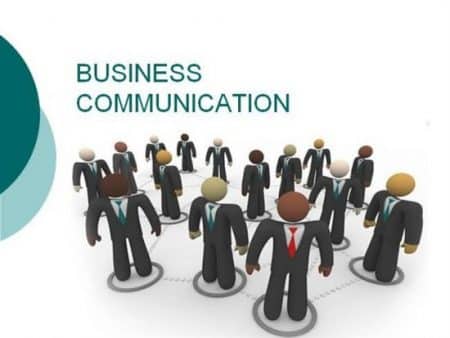Adopting an effective type of company communication is one of the simplest ways to boost earnings and morale. Unfortunately, it is not as simple as it appears.
As a result of today’s technology, business communication is changing. While it isn’t as formal as it once was, maintaining a professional tone is still crucial for projecting the correct image for your company. It’s also about fostering open and productive communication within the organization.
The appropriate form of communication can increase staff productivity, streamline processes, and boost general morale in an organization. This article offers a crash course on developing good verbal and nonverbal communication in your business in order to connect with customers and promote more productive internal discussions. We’ll also be looking at the different types and methods of business communication for effective communication.
What Is Business Communication?
Business communications refer to the exchange of information between employees both inside and outside of an organization.
Effective business communication refers to how employees and management connect with one another in order to achieve organizational goals and become more aligned with fundamental company values. So, its primary goal is to improve organizational practices, remove silos, keep people informed, and reduce errors.
Every organization’s success and growth are dependent on effective business communication. Business communication, unlike daily communication, is usually goal-oriented.
Despite this, research reveals that 60% of internal communications professionals do not track internal communications.
For an enterprise firm to be successful, all of the company’s rules, core company values, regulations, and policies must be conveyed to employees both inside and outside the organization.
Types of Business Communication
Business communications are classified into four types.
#1. Internal Upward Communication
Internal upward business communication occurs when a subordinate communicates with management or an individual higher up the organizational structure. To have a true grasp of the company’s functioning, every leader should allow information to flow upwards.
So, surveys, feedback, forms, and reports are common types of internal upward business communication that employees provide to their managers or team leaders.
A marketing report, for example, may include information such as total website traffic, social media interaction, or total leads created.
#2. Internal Downward Communication
Internal downward communication occurs when a superior communicates with one or more subordinates. This type of business communication could take the shape of a letter, a memo, or a vocal order.
When talking with employees, executives should maintain a professional and straightforward tone. A memo about a new firm operation process, such as safety requirements and new regulations, is an example of this form of communication.
#3. Internal Lateral communication
Internal lateral business communication occurs in the workplace among employees. So, employees can connect in a variety of methods nowadays, including chats, texting, email, and employee communication software solutions.
This type of communication can occur within or between departments and is more common than other types of business communication. Furthermore, frequent communication among employees is essential for employee engagement and productivity.
#4. External Communication
External business communication refers to any interaction with third-party entities such as customers, prospects, vendors, or partners.
This type of business communication occurs on a less frequent basis than all other sorts of internal company communications.
Business Communication Methods
When it comes to corporate communication, it is either vocal or written. Furthermore, communication occurs in-person/face-to-face or remotely. Neither of them is better or worse for your organization on their own; it all relies on the circumstances.
Written communication is excellent for retaining a paper trail of decisions and activities taken, as well as for developing strategies and plans. Verbal encounters allow for the instant production of ideas and a more open flow of thoughts.
Some businesses have a single location. Some have offices in different time zones. Meanwhile, others are completely remote and also lack a physical place (Buffer and Zapier are great examples of location-independent companies). These are the corporate communication approaches that apply to any or all of the scenarios listed above:
#1. Internet-based communication
This includes common business communication channels such as emails and instant messaging apps (such as Slack, Hangouts, or even Nextiva Chat).
The advantages of emails and messages include the capacity to lead private conversations in a hectic workplace environment, as well as share a message with a large group of people—from a few to hundreds—at the same time.
#2. Conference calls
Phones reduced the geographical barrier to holding effective, fast-paced meetings. It enables for more effective idea exchange because of nonverbal communication (tone of voice) as opposed to textual communication. Cloud phone systems have the potential to improve onboarding and overall team cooperation.
#3. Video Teleconference
Excellent video conferencing solutions allow people in faraway areas to hold meetings that are as near to in-person meetings as feasible. They also take phone meetings to the next level.
#4. In-person meetings
In-person discussions can help a company move ideas forward fast. According to research, in-person meetings produce more ideas than virtual ones.
A well-planned meeting agenda, on the other hand, is crucial for productive meetings. 46 percent of employees rarely or never leave a meeting knowing what to do next.
#5. Official documents and reports
Documenting activities that have an influence on other individuals and departments is an essential component of a well-oiled company communication system.
So, the capacity to refer to a written document at any time decreases the possibility of confusion or dispute and adds clarity to communication.
#6. Publications
Meetings with bigger groups are frequently conducted through presentations supplemented by reports and PowerPoint slide decks.
So, these are excellent for presenting new ideas in a way that allows for questioning and explanations.
#7. Discussion boards and FAQs
An internal location where employees may refer to commonly asked questions on various departmental topics and ask new ones that will help them be more productive and also up to speed on a subject.
#8. Questionnaires
Internal and customer surveys are both excellent ways to get input and ratings on crucial topics. Surveys provide a healthy cycle of feedback-supported changes and also open a channel of contact across all levels of a business.
#9. Customer service activities
This might encompass any type of customer service action. Live chat assistance, customer relationship management (CRM) systems, the customer onboarding process, customer feedback, and other services are examples.
So, your next logical inquiry is probably:
What Effective Business Communication Methods Does My Company Require?
The answer is mostly determined by the size and also the desires of your company. There is no such thing as a one-size-fits-all answer. One thing is certain: you will set yourself up for success if you just employ effective business communication strategies that you require and intend to use.
As an example:
You want a forum board, so you and your team spend weeks researching and setting it up.
After a while, you realize that no one is using it because their team or documents provide them with answers faster. Unnecessary solutions have cost you both time and money.
Or you invest in high-quality video conferencing equipment when all you really need is a dependable corporate phone system to handle your remote meetings.
Web-based communication will be used by all businesses. All of the other ways, on the other hand, will be determined by the unique conditions of each organization. Take the time to analyze the importance of each for your own scenario.
Read Also: Business Continuity Plan: Why Is It Important
Why is Effective Business Communication Important?
Here are the top reasons why corporate communications is critical to the success of any company:
#1. It increases employee engagement.
According to Ragan’s research on employee engagement, the top internal communication component that statistically correlates to how engaged people are in leadership communication. Internal communication teams play an important role in supporting, coaching, and reminding leaders of the necessity of communication.
#2. Reduces email overload
Email is used in businesses for a variety of purposes, including information requests, employee communications, and feedback, status reports, task assignments, communications with customers and suppliers, meeting invites, document distribution, HR notices on various team activities, benefits, and birthday wishes.
According to Radicati, the average business worker spends 25% of their workday on email-related chores.
However, only a small percentage of the emails that arrive in our inbox need our immediate attention. We separate the important emails based on the sender or subject. Furthermore, many of the emails we receive are completely irrelevant to us
#3. Boosts employee productivity
Four out of every five employees believe that efficient internal corporate communications improve their job performance.
Because of information overload, employees frequently waste time seeking content that they require to complete their jobs.
Furthermore, the average employee spends 2.5 hours every day looking for information. Hence, this results in a whole week of time lost each month to discover something that should be at the employees’ fingertips.
#4. Enhances intra-departmental communication
It is extremely difficult to maintain effective interdepartmental communications within businesses without a proper communications strategy.
Employees must be able to communicate and collaborate easily in order to be more productive.
For example, your research department must communicate with your marketing team, and your business office must communicate with the IT department.
#5. Enhances communication with remote employees
Remote teams are the way of the future. According to the Global Mobile Workforce Forecast Update, more than 40% of the world’s working population will be mobile by 2023. Furthermore, in affluent countries such as the United States, the figures could eventually exceed 75%.
This necessitates a new approach to communication, leadership, and management. Remote teams confront communication issues such as coordinating across time zones, information silos, and overcoming language and cultural obstacles. Furthermore, distance makes it difficult for team members to feel like they are part of a team.
#6. Lowers employee turnover
Employee turnover is substantially lower in companies where employees are more engaged and satisfied. Employers must ensure that their employees are kept educated on what is important to their jobs in order to attract and retain Millennials and younger generations in the workplace.
On the other hand, too much irrelevant information frequently causes stress, disengagement, and dissatisfaction, resulting in lower staff retention.
One of the primary purposes of firms engaging in internal communications is to promote information sharing best practices.
So, employers must facilitate easy information sharing within their firms in a world where employees are continually growing and learning new things.
Knowledge exchange and organizational knowledge suffer in the absence of a well-defined internal business communications plan.
Read Also: Knowledge Management: Processes, Types, Examples & Tools
#8. Boosts employee advocacy
Employers who understand how to successfully connect with their employees are far more successful in converting their staff into brand ambassadors.
Brand ambassadorship is not as difficult to obtain as many businesses imagine. In fact, satisfied employees would be eager to participate in brand ambassadorship programs.
#9. Increases client retention and satisfaction
Better corporate communication leads to higher levels of client satisfaction. When there is a breakdown in communication inside a business, Business Communication things happen in terms of customer service and satisfaction.
First, personnel in customer-facing roles will lack the necessary information. Second, clients will notice the low employee morale and have a negative experience as a result.
According to one study, employee attitude has a considerable impact on customer satisfaction, which leads to a rise in income.
What is cross-cultural business communication?
Cross-cultural business communication refers to the exchange of information, ideas, opinions, and messages between individuals or groups from different cultural backgrounds.
What is intercultural business communication?
Intercultural business communication refers to the exchange of information, ideas, opinions, and messages between individuals or groups from different cultures.
What are the challenges of intercultural business communication?
The challenges of intercultural business communication include language barriers, cultural differences, miscommunication, and lack of understanding.
What is the difference between internal and external business communication?
Internal business communication refers to communication within an organization, while external business communication refers to communication between an organization and external stakeholders.
What is the importance of active listening in business communication?
Active listening is important in business communication because it promotes understanding, reduces misunderstandings, and helps build relationships.
Business Communication FAQs
How can a business communicate better?
Effective Business Communication: 8 Steps to a Better…
- Eliminate assumptions. …
- Find a good place and time for all involved to talk. …
- To be heard, listen first. …
- Ask questions. …
- Expressing emotion is important, but always be respectful.
What are the 4 types of communication?
Every person has a unique communication style, a way in which they interact and also exchange information with others. There are four basic communication styles: passive, aggressive, passive-aggressive, and assertive. It’s important to understand each communication style, and why individuals use them.
Business Communication always has specialized content, a specific audience, a specific purpose, a specific time, and a specific place. The next important feature of business communication is clarity. Chinese Philosopher Confucius rightly remarked ‘In language clarity is everything
How can a business communicate better?
Effective Business Communication: 8 Steps to a Better…
- Eliminate assumptions. …
- Find a good place and time for all involved to talk. …
- To be heard, listen first. …
- Ask questions. …
- Expressing emotion is important, but always be respectful. …
- Pay attention to nonverbal messages.
- CONSUMER MARKET: A Step by Step Guide (All you should know)
- CHANGE AGENTS: How to Identify Change Agents in any Organization
- INTERNAL MARKETING STRATEGIES: How to Create an Effective Marketing Brand
- Marketing Communication: All you need to know (Detailed Guide)
- TYPES OF LISTENING: As It Relates to Business Communication
- Virtual Assistant Jobs: A Complete 2021 Guide (+top pick)
- DOWNWARD COMMUNICATION: Meaning, Examples & Benefits






